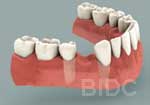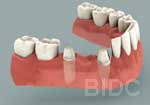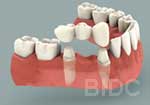What Are Bridges
Bridges are several artifical false teeth (or tooth crowns) joined together to replace the missing gap(s).
With conventional bridges, adjacent healthy teeth to the missing gap(s) would need to be permamently grinded and preped in accomodating the new bridge. The life expectancy of the adjacent surrounding teeth may compromised but is necessary to create space to support the dental bridge. Bridges may be made from all porcelain, gold alloy or a combination of porcelain with gold alloy. The four basic bridge types include traditional dental bridges, maryland, cantilever and implant-supported bridges.
A tooth bridge typically replace 1 to 2 missing gaps depending on tooth positioning. A long-span bridge spanning across 3 or more missing gaps in a row is normally not recommended but may be possible in some rare cases. Your prosthodontist will need to determine if the adjacent anchorage tooth for the long-span bridge is able to handle the biting load pressure as well as other factors. If there are 3 or more missing gaps in one row, bridges over dental implants will provide for better chewing function, comfort and life-span of use.
Pros of dental bridge
- replaces missing gaps and prevents teeth from drifting or over-erupting into empty space
- may be made to looks natural simliar to other teeth and improves appearance relative to having missing gaps
Cons of dental bridge
- there is a possibly of decay decay on underlying preped teeth
- cement used on the restoration may deterioriate over time
- gum tissues may shrink over time due to multi-factoral reasons that may exposing the junctions between the bridge and supporting teeth
- do need to be checked for wear, tear and leakages



